Analyzing Urban Planning: Rational vs. Neo-liberal Approaches
VerifiedAdded on 2020/04/07
|7
|1389
|556
Essay
AI Summary
This essay delves into the Rational-Comprehensive and Neo-liberal urban planning theories, comparing their methodologies and impacts. It evaluates how each theory addresses issues like urban sprawl and sustainability, with a particular focus on practical applications in metropolitan regions such as Sydney and Melbourne. The discussion highlights the strengths of Rational-Comprehensive planning in setting goals and assessing alternatives, while also considering the economic incentives central to Neo-liberal approaches. Ultimately, the essay argues for an integrated planning approach that leverages both theories to foster effective urban development.
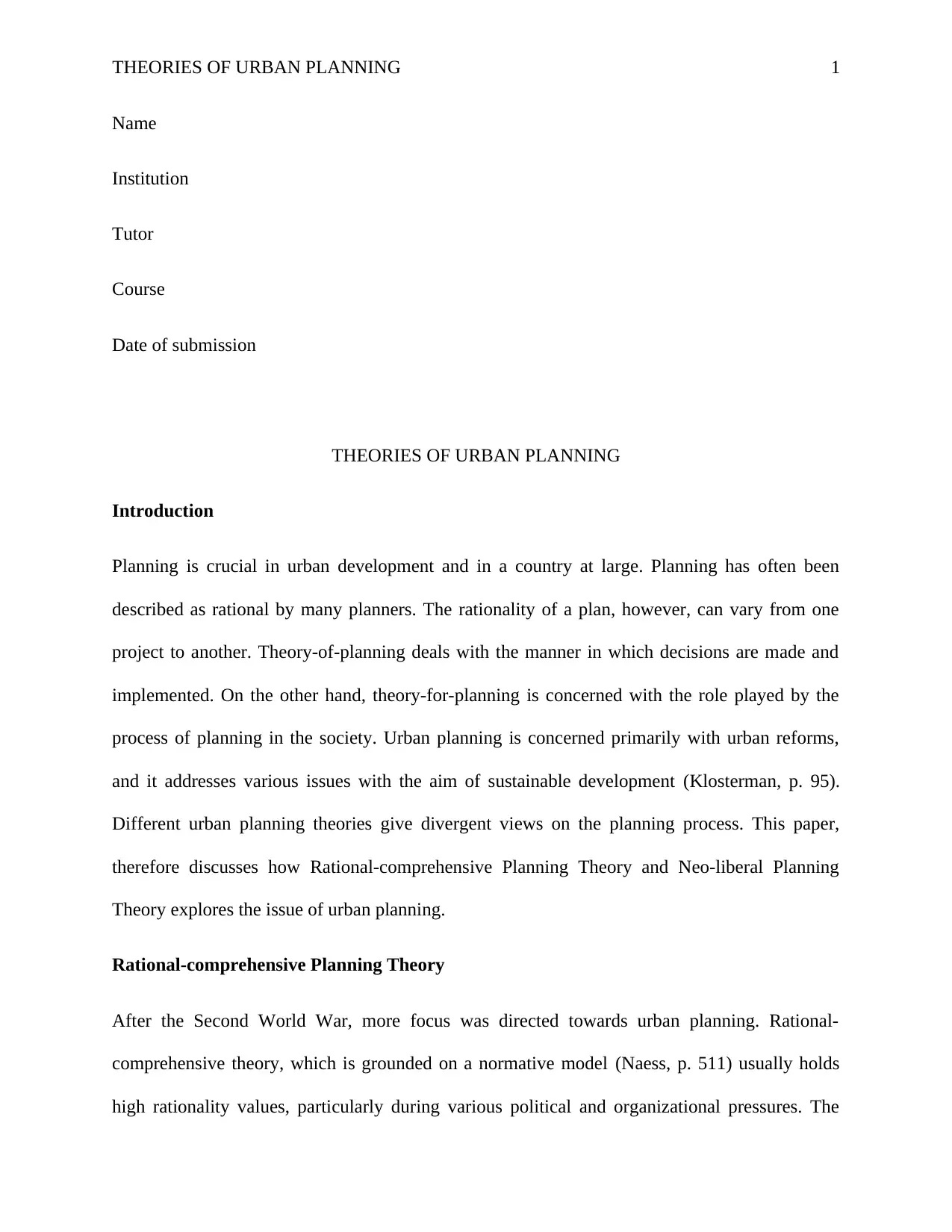
THEORIES OF URBAN PLANNING 1
Name
Institution
Tutor
Course
Date of submission
THEORIES OF URBAN PLANNING
Introduction
Planning is crucial in urban development and in a country at large. Planning has often been
described as rational by many planners. The rationality of a plan, however, can vary from one
project to another. Theory-of-planning deals with the manner in which decisions are made and
implemented. On the other hand, theory-for-planning is concerned with the role played by the
process of planning in the society. Urban planning is concerned primarily with urban reforms,
and it addresses various issues with the aim of sustainable development (Klosterman, p. 95).
Different urban planning theories give divergent views on the planning process. This paper,
therefore discusses how Rational-comprehensive Planning Theory and Neo-liberal Planning
Theory explores the issue of urban planning.
Rational-comprehensive Planning Theory
After the Second World War, more focus was directed towards urban planning. Rational-
comprehensive theory, which is grounded on a normative model (Naess, p. 511) usually holds
high rationality values, particularly during various political and organizational pressures. The
Name
Institution
Tutor
Course
Date of submission
THEORIES OF URBAN PLANNING
Introduction
Planning is crucial in urban development and in a country at large. Planning has often been
described as rational by many planners. The rationality of a plan, however, can vary from one
project to another. Theory-of-planning deals with the manner in which decisions are made and
implemented. On the other hand, theory-for-planning is concerned with the role played by the
process of planning in the society. Urban planning is concerned primarily with urban reforms,
and it addresses various issues with the aim of sustainable development (Klosterman, p. 95).
Different urban planning theories give divergent views on the planning process. This paper,
therefore discusses how Rational-comprehensive Planning Theory and Neo-liberal Planning
Theory explores the issue of urban planning.
Rational-comprehensive Planning Theory
After the Second World War, more focus was directed towards urban planning. Rational-
comprehensive theory, which is grounded on a normative model (Naess, p. 511) usually holds
high rationality values, particularly during various political and organizational pressures. The
Paraphrase This Document
Need a fresh take? Get an instant paraphrase of this document with our AI Paraphraser
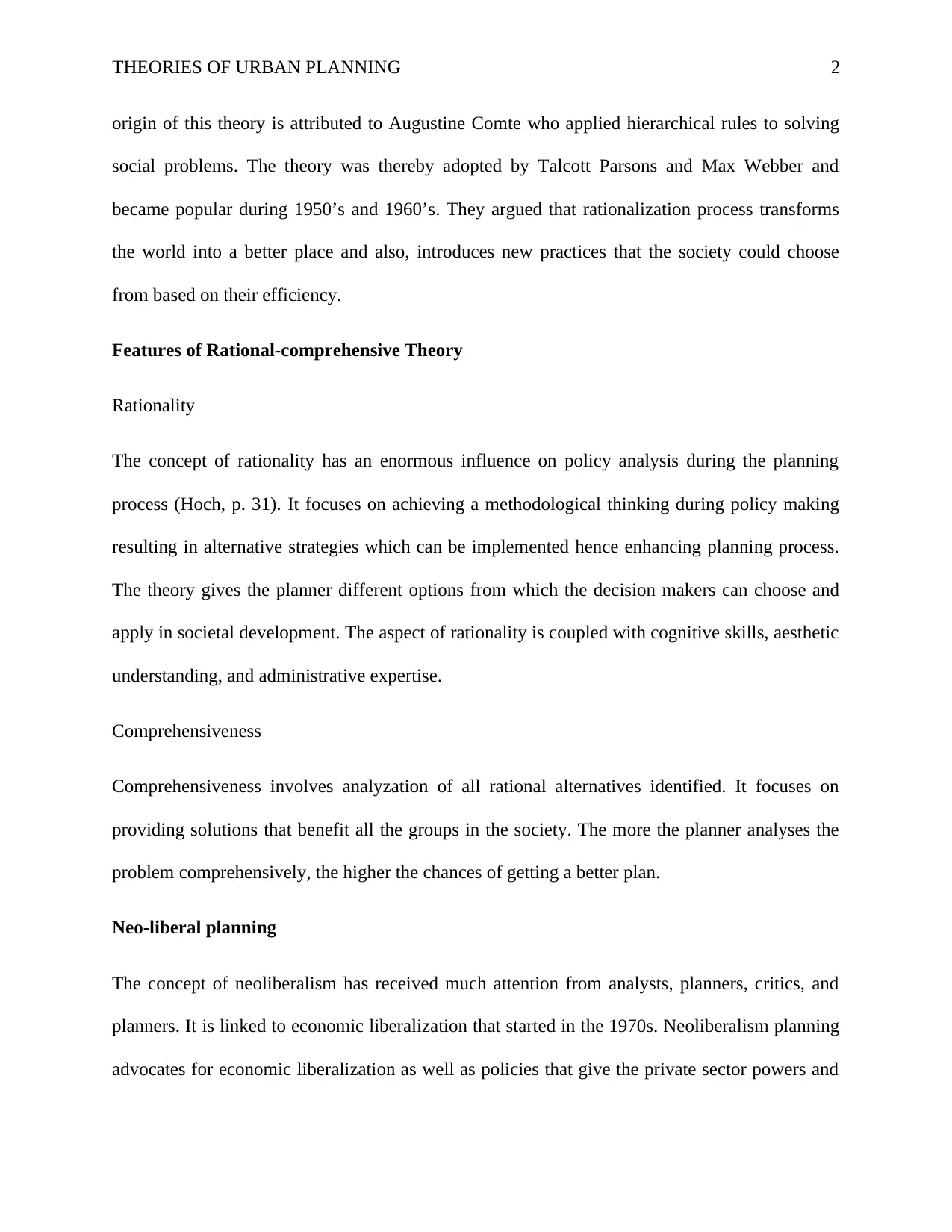
THEORIES OF URBAN PLANNING 2
origin of this theory is attributed to Augustine Comte who applied hierarchical rules to solving
social problems. The theory was thereby adopted by Talcott Parsons and Max Webber and
became popular during 1950’s and 1960’s. They argued that rationalization process transforms
the world into a better place and also, introduces new practices that the society could choose
from based on their efficiency.
Features of Rational-comprehensive Theory
Rationality
The concept of rationality has an enormous influence on policy analysis during the planning
process (Hoch, p. 31). It focuses on achieving a methodological thinking during policy making
resulting in alternative strategies which can be implemented hence enhancing planning process.
The theory gives the planner different options from which the decision makers can choose and
apply in societal development. The aspect of rationality is coupled with cognitive skills, aesthetic
understanding, and administrative expertise.
Comprehensiveness
Comprehensiveness involves analyzation of all rational alternatives identified. It focuses on
providing solutions that benefit all the groups in the society. The more the planner analyses the
problem comprehensively, the higher the chances of getting a better plan.
Neo-liberal planning
The concept of neoliberalism has received much attention from analysts, planners, critics, and
planners. It is linked to economic liberalization that started in the 1970s. Neoliberalism planning
advocates for economic liberalization as well as policies that give the private sector powers and
origin of this theory is attributed to Augustine Comte who applied hierarchical rules to solving
social problems. The theory was thereby adopted by Talcott Parsons and Max Webber and
became popular during 1950’s and 1960’s. They argued that rationalization process transforms
the world into a better place and also, introduces new practices that the society could choose
from based on their efficiency.
Features of Rational-comprehensive Theory
Rationality
The concept of rationality has an enormous influence on policy analysis during the planning
process (Hoch, p. 31). It focuses on achieving a methodological thinking during policy making
resulting in alternative strategies which can be implemented hence enhancing planning process.
The theory gives the planner different options from which the decision makers can choose and
apply in societal development. The aspect of rationality is coupled with cognitive skills, aesthetic
understanding, and administrative expertise.
Comprehensiveness
Comprehensiveness involves analyzation of all rational alternatives identified. It focuses on
providing solutions that benefit all the groups in the society. The more the planner analyses the
problem comprehensively, the higher the chances of getting a better plan.
Neo-liberal planning
The concept of neoliberalism has received much attention from analysts, planners, critics, and
planners. It is linked to economic liberalization that started in the 1970s. Neoliberalism planning
advocates for economic liberalization as well as policies that give the private sector powers and
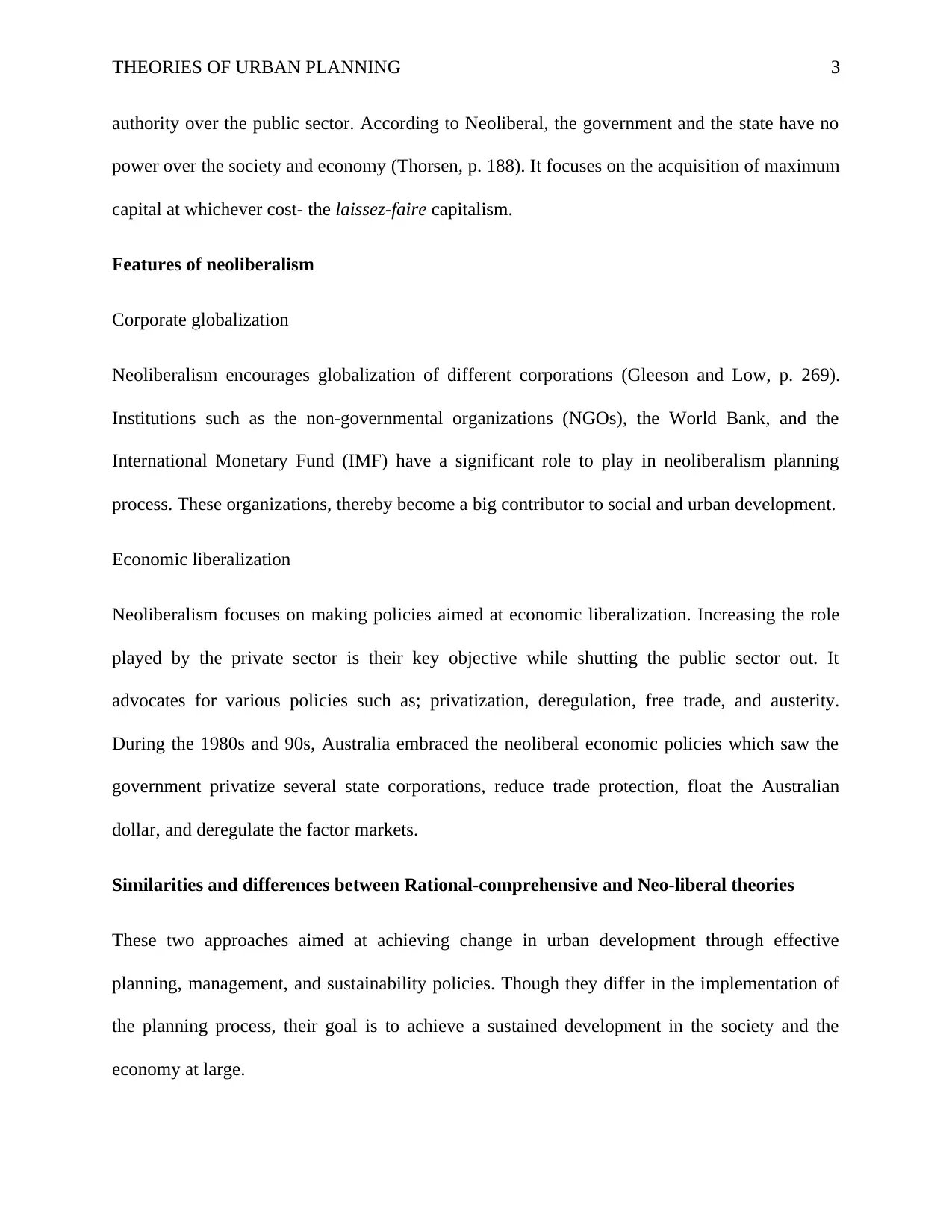
THEORIES OF URBAN PLANNING 3
authority over the public sector. According to Neoliberal, the government and the state have no
power over the society and economy (Thorsen, p. 188). It focuses on the acquisition of maximum
capital at whichever cost- the laissez-faire capitalism.
Features of neoliberalism
Corporate globalization
Neoliberalism encourages globalization of different corporations (Gleeson and Low, p. 269).
Institutions such as the non-governmental organizations (NGOs), the World Bank, and the
International Monetary Fund (IMF) have a significant role to play in neoliberalism planning
process. These organizations, thereby become a big contributor to social and urban development.
Economic liberalization
Neoliberalism focuses on making policies aimed at economic liberalization. Increasing the role
played by the private sector is their key objective while shutting the public sector out. It
advocates for various policies such as; privatization, deregulation, free trade, and austerity.
During the 1980s and 90s, Australia embraced the neoliberal economic policies which saw the
government privatize several state corporations, reduce trade protection, float the Australian
dollar, and deregulate the factor markets.
Similarities and differences between Rational-comprehensive and Neo-liberal theories
These two approaches aimed at achieving change in urban development through effective
planning, management, and sustainability policies. Though they differ in the implementation of
the planning process, their goal is to achieve a sustained development in the society and the
economy at large.
authority over the public sector. According to Neoliberal, the government and the state have no
power over the society and economy (Thorsen, p. 188). It focuses on the acquisition of maximum
capital at whichever cost- the laissez-faire capitalism.
Features of neoliberalism
Corporate globalization
Neoliberalism encourages globalization of different corporations (Gleeson and Low, p. 269).
Institutions such as the non-governmental organizations (NGOs), the World Bank, and the
International Monetary Fund (IMF) have a significant role to play in neoliberalism planning
process. These organizations, thereby become a big contributor to social and urban development.
Economic liberalization
Neoliberalism focuses on making policies aimed at economic liberalization. Increasing the role
played by the private sector is their key objective while shutting the public sector out. It
advocates for various policies such as; privatization, deregulation, free trade, and austerity.
During the 1980s and 90s, Australia embraced the neoliberal economic policies which saw the
government privatize several state corporations, reduce trade protection, float the Australian
dollar, and deregulate the factor markets.
Similarities and differences between Rational-comprehensive and Neo-liberal theories
These two approaches aimed at achieving change in urban development through effective
planning, management, and sustainability policies. Though they differ in the implementation of
the planning process, their goal is to achieve a sustained development in the society and the
economy at large.
⊘ This is a preview!⊘
Do you want full access?
Subscribe today to unlock all pages.

Trusted by 1+ million students worldwide
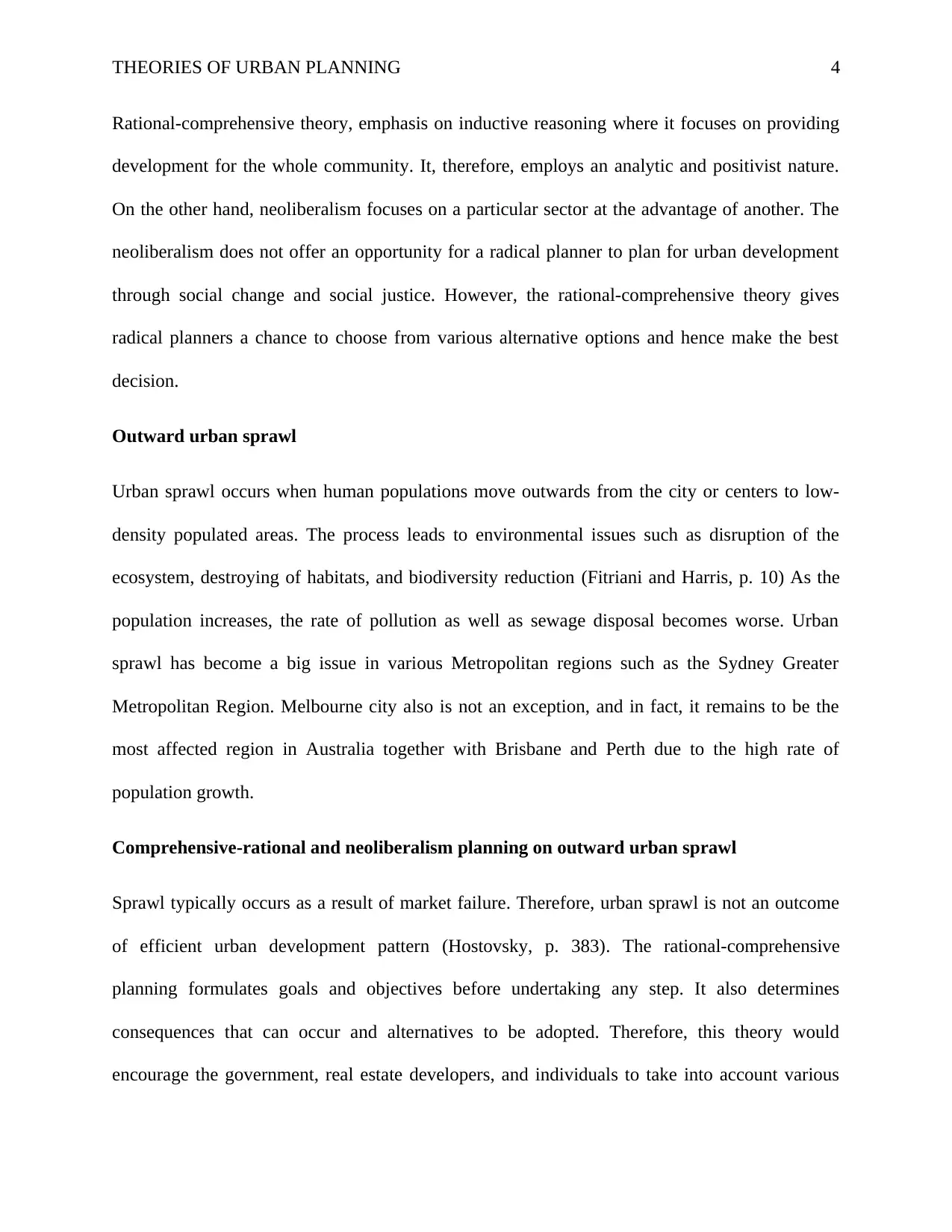
THEORIES OF URBAN PLANNING 4
Rational-comprehensive theory, emphasis on inductive reasoning where it focuses on providing
development for the whole community. It, therefore, employs an analytic and positivist nature.
On the other hand, neoliberalism focuses on a particular sector at the advantage of another. The
neoliberalism does not offer an opportunity for a radical planner to plan for urban development
through social change and social justice. However, the rational-comprehensive theory gives
radical planners a chance to choose from various alternative options and hence make the best
decision.
Outward urban sprawl
Urban sprawl occurs when human populations move outwards from the city or centers to low-
density populated areas. The process leads to environmental issues such as disruption of the
ecosystem, destroying of habitats, and biodiversity reduction (Fitriani and Harris, p. 10) As the
population increases, the rate of pollution as well as sewage disposal becomes worse. Urban
sprawl has become a big issue in various Metropolitan regions such as the Sydney Greater
Metropolitan Region. Melbourne city also is not an exception, and in fact, it remains to be the
most affected region in Australia together with Brisbane and Perth due to the high rate of
population growth.
Comprehensive-rational and neoliberalism planning on outward urban sprawl
Sprawl typically occurs as a result of market failure. Therefore, urban sprawl is not an outcome
of efficient urban development pattern (Hostovsky, p. 383). The rational-comprehensive
planning formulates goals and objectives before undertaking any step. It also determines
consequences that can occur and alternatives to be adopted. Therefore, this theory would
encourage the government, real estate developers, and individuals to take into account various
Rational-comprehensive theory, emphasis on inductive reasoning where it focuses on providing
development for the whole community. It, therefore, employs an analytic and positivist nature.
On the other hand, neoliberalism focuses on a particular sector at the advantage of another. The
neoliberalism does not offer an opportunity for a radical planner to plan for urban development
through social change and social justice. However, the rational-comprehensive theory gives
radical planners a chance to choose from various alternative options and hence make the best
decision.
Outward urban sprawl
Urban sprawl occurs when human populations move outwards from the city or centers to low-
density populated areas. The process leads to environmental issues such as disruption of the
ecosystem, destroying of habitats, and biodiversity reduction (Fitriani and Harris, p. 10) As the
population increases, the rate of pollution as well as sewage disposal becomes worse. Urban
sprawl has become a big issue in various Metropolitan regions such as the Sydney Greater
Metropolitan Region. Melbourne city also is not an exception, and in fact, it remains to be the
most affected region in Australia together with Brisbane and Perth due to the high rate of
population growth.
Comprehensive-rational and neoliberalism planning on outward urban sprawl
Sprawl typically occurs as a result of market failure. Therefore, urban sprawl is not an outcome
of efficient urban development pattern (Hostovsky, p. 383). The rational-comprehensive
planning formulates goals and objectives before undertaking any step. It also determines
consequences that can occur and alternatives to be adopted. Therefore, this theory would
encourage the government, real estate developers, and individuals to take into account various
Paraphrase This Document
Need a fresh take? Get an instant paraphrase of this document with our AI Paraphraser
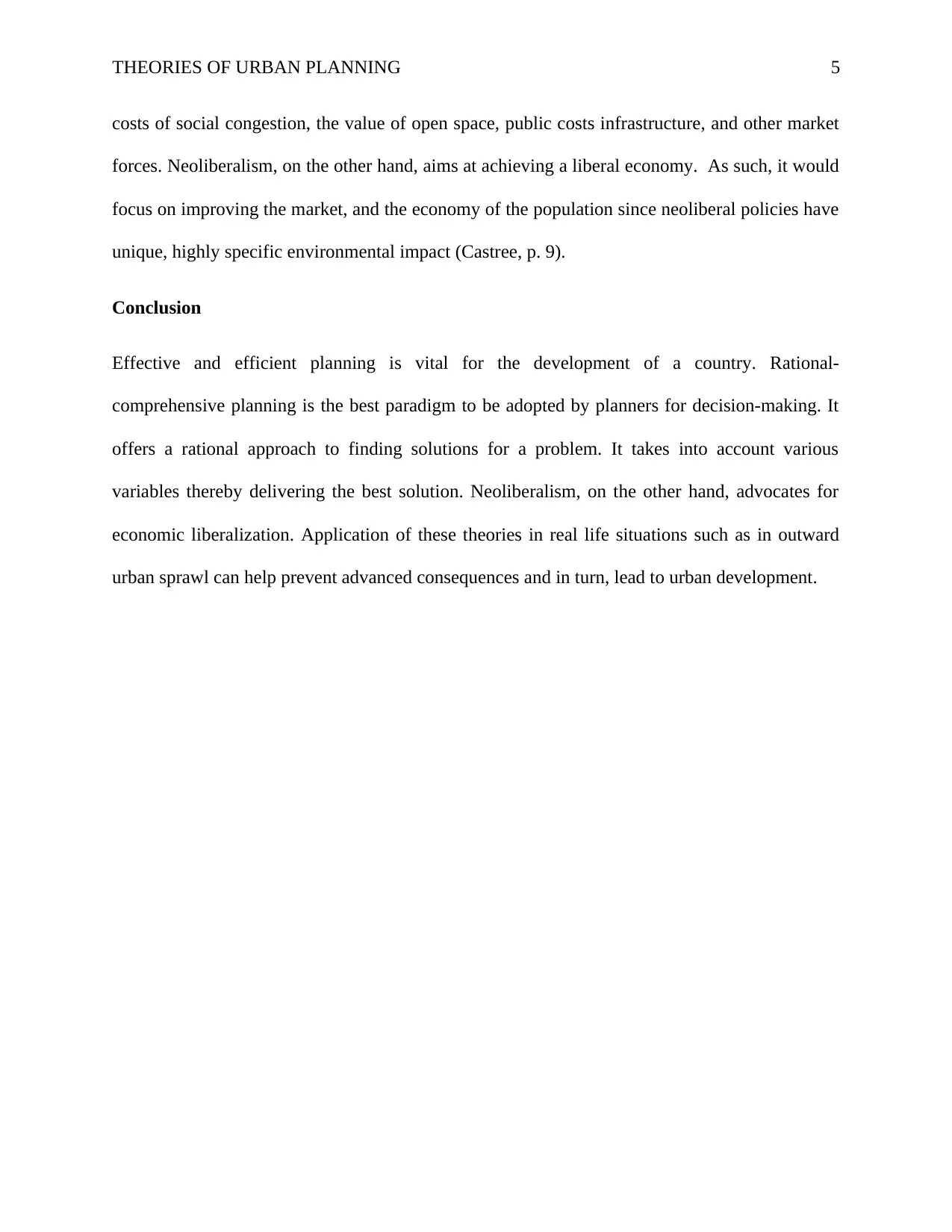
THEORIES OF URBAN PLANNING 5
costs of social congestion, the value of open space, public costs infrastructure, and other market
forces. Neoliberalism, on the other hand, aims at achieving a liberal economy. As such, it would
focus on improving the market, and the economy of the population since neoliberal policies have
unique, highly specific environmental impact (Castree, p. 9).
Conclusion
Effective and efficient planning is vital for the development of a country. Rational-
comprehensive planning is the best paradigm to be adopted by planners for decision-making. It
offers a rational approach to finding solutions for a problem. It takes into account various
variables thereby delivering the best solution. Neoliberalism, on the other hand, advocates for
economic liberalization. Application of these theories in real life situations such as in outward
urban sprawl can help prevent advanced consequences and in turn, lead to urban development.
costs of social congestion, the value of open space, public costs infrastructure, and other market
forces. Neoliberalism, on the other hand, aims at achieving a liberal economy. As such, it would
focus on improving the market, and the economy of the population since neoliberal policies have
unique, highly specific environmental impact (Castree, p. 9).
Conclusion
Effective and efficient planning is vital for the development of a country. Rational-
comprehensive planning is the best paradigm to be adopted by planners for decision-making. It
offers a rational approach to finding solutions for a problem. It takes into account various
variables thereby delivering the best solution. Neoliberalism, on the other hand, advocates for
economic liberalization. Application of these theories in real life situations such as in outward
urban sprawl can help prevent advanced consequences and in turn, lead to urban development.
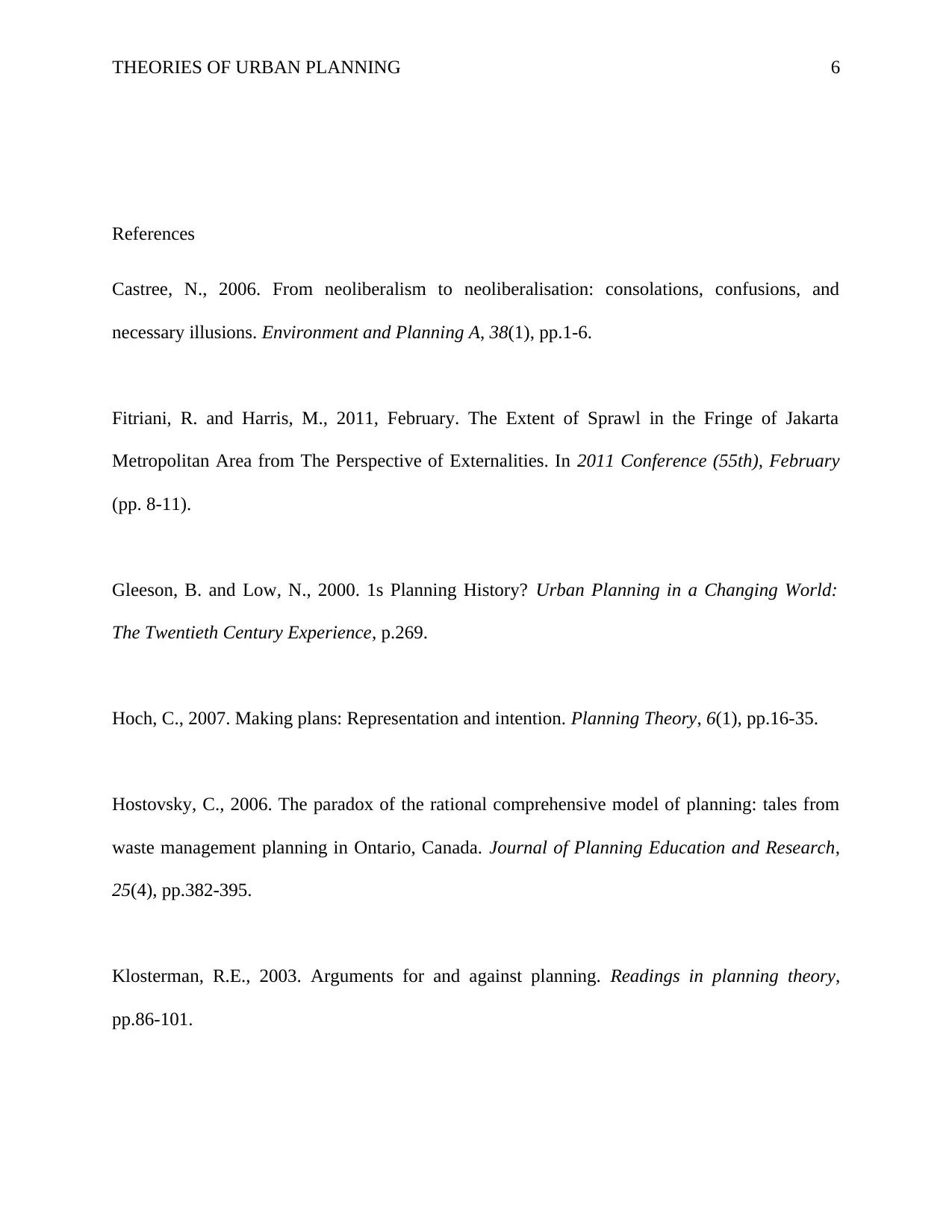
THEORIES OF URBAN PLANNING 6
References
Castree, N., 2006. From neoliberalism to neoliberalisation: consolations, confusions, and
necessary illusions. Environment and Planning A, 38(1), pp.1-6.
Fitriani, R. and Harris, M., 2011, February. The Extent of Sprawl in the Fringe of Jakarta
Metropolitan Area from The Perspective of Externalities. In 2011 Conference (55th), February
(pp. 8-11).
Gleeson, B. and Low, N., 2000. 1s Planning History? Urban Planning in a Changing World:
The Twentieth Century Experience, p.269.
Hoch, C., 2007. Making plans: Representation and intention. Planning Theory, 6(1), pp.16-35.
Hostovsky, C., 2006. The paradox of the rational comprehensive model of planning: tales from
waste management planning in Ontario, Canada. Journal of Planning Education and Research,
25(4), pp.382-395.
Klosterman, R.E., 2003. Arguments for and against planning. Readings in planning theory,
pp.86-101.
References
Castree, N., 2006. From neoliberalism to neoliberalisation: consolations, confusions, and
necessary illusions. Environment and Planning A, 38(1), pp.1-6.
Fitriani, R. and Harris, M., 2011, February. The Extent of Sprawl in the Fringe of Jakarta
Metropolitan Area from The Perspective of Externalities. In 2011 Conference (55th), February
(pp. 8-11).
Gleeson, B. and Low, N., 2000. 1s Planning History? Urban Planning in a Changing World:
The Twentieth Century Experience, p.269.
Hoch, C., 2007. Making plans: Representation and intention. Planning Theory, 6(1), pp.16-35.
Hostovsky, C., 2006. The paradox of the rational comprehensive model of planning: tales from
waste management planning in Ontario, Canada. Journal of Planning Education and Research,
25(4), pp.382-395.
Klosterman, R.E., 2003. Arguments for and against planning. Readings in planning theory,
pp.86-101.
⊘ This is a preview!⊘
Do you want full access?
Subscribe today to unlock all pages.

Trusted by 1+ million students worldwide

THEORIES OF URBAN PLANNING 7
Naess, P., 2001. Urban planning and sustainable development. European Planning Studies, 9(4),
pp.503-524.
Thorsen, D.E., 2010. The Neoliberal Challenge-What is Neoliberalism. Contemp. Readings L. &
Soc. Just., 2, p.188.
Naess, P., 2001. Urban planning and sustainable development. European Planning Studies, 9(4),
pp.503-524.
Thorsen, D.E., 2010. The Neoliberal Challenge-What is Neoliberalism. Contemp. Readings L. &
Soc. Just., 2, p.188.
1 out of 7
Related Documents
Your All-in-One AI-Powered Toolkit for Academic Success.
+13062052269
info@desklib.com
Available 24*7 on WhatsApp / Email
![[object Object]](/_next/static/media/star-bottom.7253800d.svg)
Unlock your academic potential
Copyright © 2020–2025 A2Z Services. All Rights Reserved. Developed and managed by ZUCOL.



